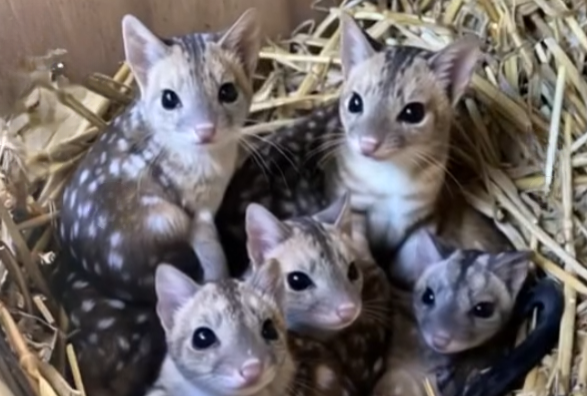Researchers Celebrate Remarkable Discovery of Rare Creatures in Australia

In a time when environmental challenges often dominate the headlines, a story of hope has emerged from the heart of Western Australia. At Mt. Gibson Wildlife Sanctuary, researchers have witnessed an event that is both rare and deeply symbolic — the successful birth of western quolls, also known by their Aboriginal name chuditch. These small marsupials, once abundant across the Australian continent, have now taken a step toward recovery thanks to years of conservation work.
The discovery was made during a routine survey conducted by ecologists and wildlife experts at the sanctuary. As researchers carefully checked the pouches of female quolls, they were delighted to find tiny newborns nestled safely inside. For many in the conservation community, this wasn’t just another scientific achievement — it was living proof that reintroduction programs and careful protection efforts can make a tangible difference.
This birth marks a turning point for the western quoll and serves as a broader reminder of how ecosystems can begin to heal when nature is given the chance.
The Significance of the Western Quoll
To understand why this discovery is so important, it helps to know more about the species itself. The western quoll (Dasyurus geoffroii) is a carnivorous marsupial, roughly the size of a domestic cat. Agile and nocturnal, quolls are skilled hunters that prey on insects, reptiles, and small mammals. In doing so, they play a vital ecological role — keeping populations of smaller species in balance and maintaining the natural health of Australia’s landscapes.
For thousands of years, quolls thrived across most of mainland Australia. However, with the arrival of European settlers, their numbers began to decline rapidly. Habitat destruction from land clearing, the introduction of invasive predators such as foxes and feral cats, and other human-related pressures pushed quolls toward extinction in much of their former range.
Today, their natural distribution is limited to a small corner of southwestern Australia. This drastic reduction makes every effort to re-establish them in safe habitats critical for their survival. The fact that baby quolls are now being born at Mt. Gibson shows that recovery, while difficult, is indeed possible.
The Role of Mt. Gibson Wildlife Sanctuary
The Mt. Gibson Wildlife Sanctuary, managed by the Australian Wildlife Conservancy (AWC), has become one of the most important strongholds for threatened species recovery in the country. The sanctuary spans thousands of hectares, providing a protected environment where vulnerable animals can live without the constant threat of introduced predators.
AWC’s mission goes far beyond simply protecting land. The organization actively restores ecosystems through a combination of predator control, reintroduction of endangered species, and ongoing scientific monitoring. By building large, predator-proof enclosures and dedicating resources to long-term ecological management, AWC has created conditions where species like the western quoll can not only survive but also begin to thrive once again.
The recent discovery of quoll joeys at Mt. Gibson is a major success for the sanctuary’s long-term conservation goals. It demonstrates that careful planning, combined with patience and dedication, can lead to real results even in the face of overwhelming environmental challenges.
A Species Once on the Brink
The story of the western quoll is one of both tragedy and resilience. Once, these animals roamed across most of Australia, adapting to a variety of habitats from forests to deserts. They were respected by Indigenous communities and played an essential role in natural food webs.
However, within just two centuries of European colonization, quolls had disappeared from nearly all of their range. Feral cats and red foxes, introduced to Australia during the 19th century, proved to be devastating predators. Quolls, unfamiliar with these new threats, were easy targets. At the same time, widespread land clearing for agriculture reduced the habitats they depended on.
By the late 20th century, the western quoll was hanging on only in isolated pockets of Western Australia. Without urgent intervention, extinction on the mainland seemed inevitable.
The current births at Mt. Gibson prove that this grim prediction can be reversed when action is taken. Instead of fading away, quolls now have the opportunity to reclaim parts of their former home.